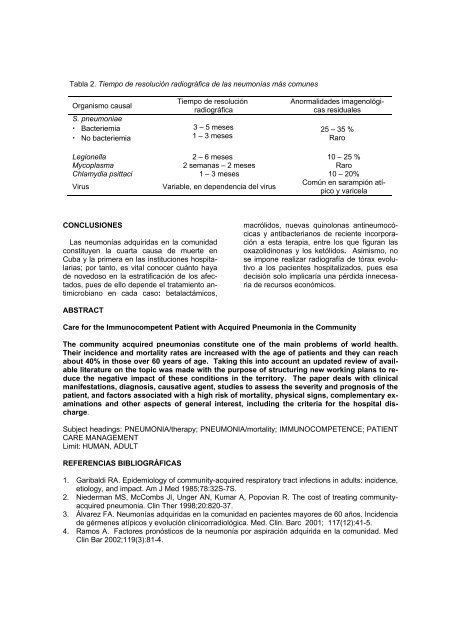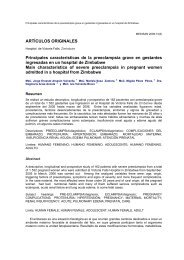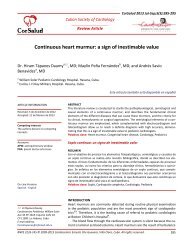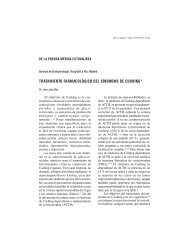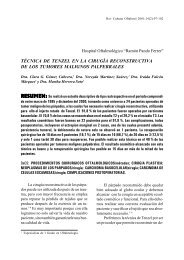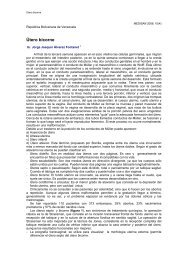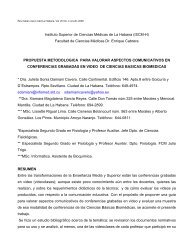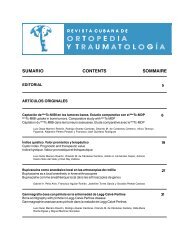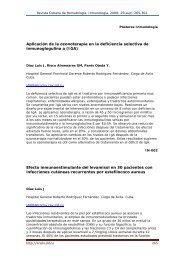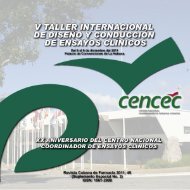Formato .PDF
Formato .PDF
Formato .PDF
Create successful ePaper yourself
Turn your PDF publications into a flip-book with our unique Google optimized e-Paper software.
Tabla 2. Tiempo de resolución radiográfica de las neumonías más comunes<br />
Organismo causal<br />
S. pneumoniae<br />
• Bacteriemia<br />
• No bacteriemia<br />
Tiempo de resolución<br />
radiográfica<br />
3 – 5 meses<br />
1 – 3 meses<br />
Anormalidades imagenológicas<br />
residuales<br />
25 – 35 %<br />
Raro<br />
Legionella 2 – 6 meses 10 – 25 %<br />
Mycoplasma 2 semanas – 2 meses Raro<br />
Chlamydia psittaci 1 – 3 meses 10 – 20%<br />
Virus Variable, en dependencia del virus<br />
Común en sarampión atípico<br />
y varicela<br />
CONCLUSIONES<br />
Las neumonías adquiridas en la comunidad<br />
constituyen la cuarta causa de muerte en<br />
Cuba y la primera en las instituciones hospitalarias;<br />
por tanto, es vital conocer cuánto haya<br />
de novedoso en la estratificación de los afectados,<br />
pues de ello depende el tratamiento antimicrobiano<br />
en cada caso: betalactámicos,<br />
ABSTRACT<br />
macrólidos, nuevas quinolonas antineumocócicas<br />
y antibacterianos de reciente incorporación<br />
a esta terapia, entre los que figuran las<br />
oxazolidinonas y los ketólidos. Asimismo, no<br />
se impone realizar radiografía de tórax evolutivo<br />
a los pacientes hospitalizados, pues esa<br />
decisión solo implicaría una pérdida innecesaria<br />
de recursos económicos.<br />
Care for the Immunocompetent Patient with Acquired Pneumonia in the Community<br />
The community acquired pneumonias constitute one of the main problems of world health.<br />
Their incidence and mortality rates are increased with the age of patients and they can reach<br />
about 40% in those over 60 years of age. Taking this into account an updated review of available<br />
literature on the topic was made with the purpose of structuring new working plans to reduce<br />
the negative impact of these conditions in the territory. The paper deals with clinical<br />
manifestations, diagnosis, causative agent, studies to assess the severity and prognosis of the<br />
patient, and factors associated with a high risk of mortality, physical signs, complementary examinations<br />
and other aspects of general interest, including the criteria for the hospital discharge.<br />
Subject headings: PNEUMONIA/therapy; PNEUMONIA/mortality; IMMUNOCOMPETENCE; PATIENT<br />
CARE MANAGEMENT<br />
Limit: HUMAN, ADULT<br />
REFERENCIAS BIBLIOGRÁFICAS<br />
1. Garibaldi RA. Epidemiology of community-acquired respiratory tract infections in adults: incidence,<br />
etiology, and impact. Am J Med 1985;78:32S-7S.<br />
2. Niederman MS, McCombs JI, Unger AN, Kumar A, Popovian R. The cost of treating communityacquired<br />
pneumonia. Clin Ther 1998;20:820-37.<br />
3. Álvarez FA. Neumonías adquiridas en la comunidad en pacientes mayores de 60 años. Incidencia<br />
de gérmenes atípicos y evolución clinicorradiológica. Med. Clin. Barc 2001; 117(12):41-5.<br />
4. Ramos A. Factores pronósticos de la neumonía por aspiración adquirida en la comunidad. Med<br />
Clin Bar 2002;119(3):81-4.


